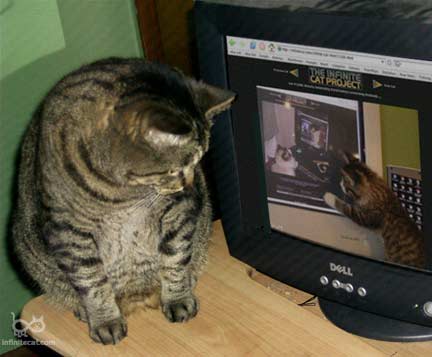| Previous Cat |  |
 |

|
Next Cat |

|
The Infinite Cat Project
Presented by Mike Stanfill, Private Hand
Illustration, Flash Animation, Web Design
www.privatehand.com
|
Magic, including the arts of prestidigitation and conjuring, is
the art of entertaining an audience by performing illusions that
baffle and amaze, often by giving the impression that something
impossible has been achieved, almost as if the performer had magic
or supernatural powers. Yet, this illusion of magic is created entirely
by natural means. The practitioners of this mystery art may be called
magicians, conjurors, illusionists or prestidigitators. Artists
in other media such as theatre, cinema, dance and the visual arts
increasingly work using similar means but regard their magical techniques
as of secondary importance to the goal of creating a complex cultural
performance. Performances we would recognise as conjuring have probably been practised throughout history. The same ingenuity behind ancient deceptions such as the Trojan horse would have been used for entertainment, or at least for cheating in gambling games, since time immemorial. However, the respectable profession of the illusionist gained strength during the eighteenth century, and has enjoyed several popular vogues. Successful magicians have become some of the most famous celebrities in popular entertainment. Jean Eugène Robert-Houdin, the first modern magician. Modern entertainment magic owes much of its origins to Jean Eugène Robert-Houdin (1805-1871), originally a clockmaker, who opened a magic theatre in Paris in the 1840s. His speciality was the construction of mechanical automata which appeared to move and act as if they were alive. The British performer J N Maskelyne and his partner Cooke established their own theatre, the Egyptian Hall in London's Piccadilly, in 1873. They presented stage magic, exploiting the potential of the stage for hidden mechanisms and assistants, and the control it offers over the audience's point of view. The greatest celebrity magician of the nineteenth century (or possibly of all time), Harry Houdini (real name Erich Weiss, 1874 - 1926), took his stage name from Robert-Houdin and developed a range of stage magic tricks, many of them based on escapology (though that word was not used until after Houdini's death). The son of a Hungarian rabbi, Houdini was genuinely highly skilled in techniques such as lockpicking and escaping straitjackets, but also made full use of the whole range of conjuring techniques, including fake equipment and collusion with individuals in the audience. Houdini's showbusiness savvy was as great as his performing skill. In addition to expanding the range of magic hardware, showmanship and deceptive technique, these performers established the modern relationship between the performer and the audience. |